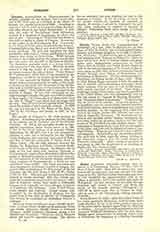

Durazzo, Archdiocese of (DYRRACHIENSIS), in Albania, situated on the Adriatic, has a good port, and is the chief town of a sandjak in the vilayet of Scutari; the population is about 9000. According to Appian it was founded by a barbarian king, Epidamnus, after whom it was called Epidamnum; it then took the name of Dyrrachium, from Dyrrachus, nephew of a daughter of Epidamnus, to whom was due its port. According to Thucydides and Strabo it was more probably a colony of Corcyra. It was one of the causes of the Peloponnesian War. Conquered by the kings of Illyria, when attacked by the Romans, it surrendered to the latter and received from Rome many privileges. Its port was important for communication with Greece. Cicero and Pompey in their disgrace took refuge at Dyrrachium. When towards the end of the fourth century the empire was divided into two parts, the city fell to the Eastern Empire. The Byzantine emperors made it a strong fortress, and Anastasius I was born there. After the seventh century it was the center of a theme; in 1011 its governors received the title of dukes. Under Michael the Paphlagonian (1034-1041) it was occupied by the Bulgarians; in 1042 it was retaken by the Greeks. In 1082 it was captured by Robert Guiscard, who defeated Alexius Comnenus under its walls; at the death of Robert it fell again into the power of the Greeks, who held it till the capture of Constantinople by the Latins (1204). From 1206 to 1294 it belonged to the despots of Epirus. It was then conquered by the Angevin kings of Naples, who gave it as a fief to princes of their family; the descendants of these rulers kept the title of “Duras” even when they no longer held the city. The effective lordship passed to the Thopias about the middle of the fourteenth century. In 1373 the city was occupied by the Balsas of the Zetta, in 1386 by the Venetians, and finally, in 1501, by the Turks.
The church of Durazzo is the most ancient in Albania. According to local tradition the first bishop of the country was St. Caesarius, one of the Seventy Disciples. St. Astius, his successor, is said to have suffered martyrdom under Trajan about A.D. 100. A list of the Greek bishops is in Lequien (Oriens Christianus, II, 240-247), but it is very incomplete. Durazzo is even yet a metropolis for the Greeks. Under Eucharius, who attended the Council of Ephesus, 431, it was the metropolis of Epirus Nova or Illyria Graeca. The see, long disputed between the Greeks, the Bulgarians, and Serbs, remained finally in the hands of the first named. Its bishops, who as early as 519 had sided with Acacius, Patriarch of Constantinople, against Pope Hormisdas, followed the schism of Michael Caerularius in the eleventh century. At the beginning of the thirteenth century, after the Latin conquest of Constantinople, a Latin see was established there (1209). The Latin succession was often interrupted, on account of political changes; the actual (1908) archbishop is the fifty-second of the list (Lequien, III, 950-954; Gams, I, 407; II, 87; Eubel, I, 241; II, 164). The episcopal residence was likewise subject to several removals; after the Turkish conquest the archbishops transferred it to Corbina (1509), then to Canovia; today they reside at Delbenisti. Durazzo had originally but one suffragan, Cernicum or Tzernicum, site unknown. Later it had Prisca, Croia, Alessio, and Canovia. Today Alessio only is subject to the Archbishop of Durazzo, but his power over it has been so limited by Propaganda that he may be considered an archbishop without a suffragan.
There are in the archdiocese about 250,000 inhabitants, of whom about 140,000 are Mussulmans (Turks and chiefly Albanese), 95,000 Greeks or Griecized Albanese, 14,000 Catholics (Albanese, except a few Italians and Austrians). There are also at Elbassan about 150 recently converted Greeks. The diocese has no seminary, but some students are sent to the seminary of Scutari. It has 20 priests, of whom 13 are secular priests, 22 parishes, 46 churches or chapels, 39 stations, 5 schools for boys and 1 for girls (the latter conducted by Sisters of Charity of Agram). Franciscan friars have charge of several parishes.
L. PETIT

